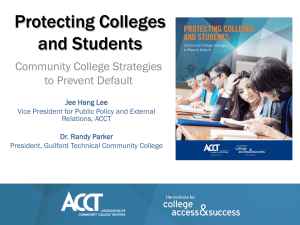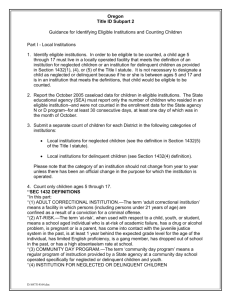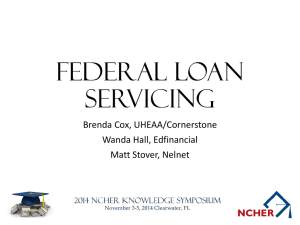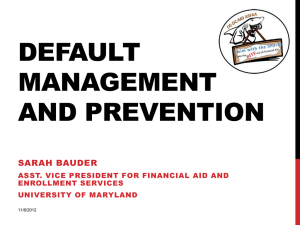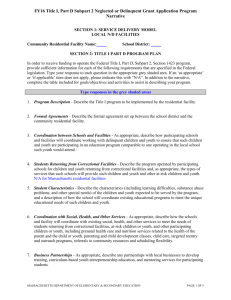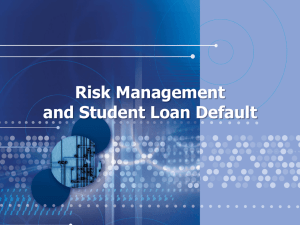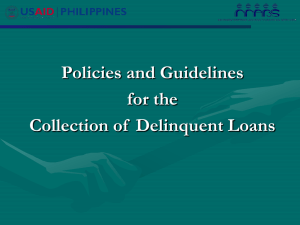Default Prevention
advertisement
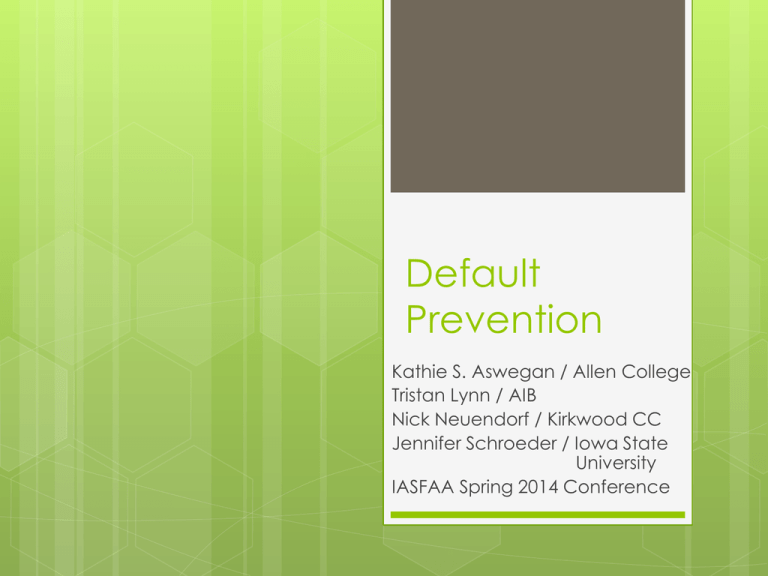
Default Prevention Kathie S. Aswegan / Allen College Tristan Lynn / AIB Nick Neuendorf / Kirkwood CC Jennifer Schroeder / Iowa State University IASFAA Spring 2014 Conference Why? It may be required. Required time. for schools using DL for the 1st 34 CFR 668.14 (b)(15) Required for schools using DL & have had a change in ownership. 34 CFR 668.14 (b)(15) Required for schools with a default rate of 30% or higher. 34 CFR 668.217 Why? You may be interested If you aren’t interested in CDR, you should be. Improve student success Save tax dollars It’s strongly encouraged by D. E. (Gen-05-14) It’s the right thing to do for students!! Who? Team approach Default prevention is not only the responsibility of the financial aid office. Increase ideas Suggested members: financial aid, admissions, registrar, student services, bursar/BO, academic advising What to do next? Educate the team CDR – current and historical % of students receiving financial aid % of students graduating with debt Average debt Who is defaulting? Evaluate your current activities What are you currently doing on your campus that may or may not have an impact on your default rate? Entrance counseling Exit counseling Timely enrollment reporting to NSLDS SAP. Do you share information across your campus? What else could we do? Analyze default information Delinquent borrower follow up Additional attention/follow up to students who withdraw Reminder notice during grace period Additional in school counseling Defaulted borrower out reach & encourage loan rehabilitation Financial Literacy… Financial Literacy…Budgeting, Borrowing, & Repayment 1. Budgeting A Financial Literacy program 2. Borrowing should include these elements 3. Repayment Create a plan Create a unique plan based on your data. What are other schools doing? ED’s sample default prevention & management plan www.ifap.ed.gov/qahome/qaassessments/ defaultmanagement.html If you have questions, contact defaultpreventionassistance@ed.gov What’s next? Communicate your plan across campus. Implement 1 item at a time. Collect data about activities and the number of students served, etc.. U.S. D.E. Tools StudentAid.gov o o o Budgeting Borrowing Repayment National Student Loan Data System as a tool for both schools and students http://www.nslds.ed.gov/ Financial Awareness Counseling Tool (FACT) http://studentaid.ed.gov/about/announcements/fact Direct Loan Repayment Estimator https://studentloans.gov/myDirectLoan/counselingIn struc Panel member information Tristan Lynn, Director of Financial Aid AIB College of Business lynnt@aib.edu 515-246-5354 2010 3yr CDR 12.2% (46 students) 2011 3yr draft CDR 7.9% (31 Students) Current activities: Monthly delinquency report from NSLDS, 100 day or less, letter and phone call immediately, 365 days or less, letter every 3 months Letter contains information on default and prevention methods along with Economic Hardships and Unemployment Deferment request forms. Currently evaluating data of defaulted students to determine characteristics and develop strategy to educate while they are still students. Panel member information Nick Neuendorf, Financial Aid Advisor Kirkwood Community College Nick.neuendorf@kirkwood.edu 319-398-7783 2009 3yr CDR 15% (606 students) 2010 3yr CDR 22.9% (1,061 students) 2011 3yr draft CDR 24.6% (1,448 students) Current Activities: ·Outreach Program (Communicate with former students & graduates to educate them on current options with their federal student loans) We use the NSLDS Delinquent Borrower Report to contact our delinquent borrowers on a monthly basis 1) Early Stage Delinquent Borrowers (30 – 120 days delinquent) –Receive friendly reminder email every 90 days 2) Mid Stage Delinquent Borrowers (121-240 days delinquent) –Receive a more urgent email every 60 days 3) Late Stage Delinquent Borrowers (241-360 days delinquent) –Receive a very serious email every 30 days, if no email on file, then we send a letter. We also call this group every 30 days · Financial Literacy Program (Communicate with the current student population to increase financial literacy so they are better prepared to manage student loans upon graduation) Students activating an Unsubsidized Stafford Loan must complete Financial Awareness Counseling through www.studentloans.gov in order to receive the UNSUB loan Financial Literacy 101 Presentation (presented to our traditional students in their 1st semester on campus enrolled in the College 101 course) Educates students on the financial aid process, creating a budget, repaying student loans, using credit cards responsibly, monitoring your credit report Panel member information Jennifer Schroeder, Student Loan Counselor Iowa State University jschroed@iastate.edu 515-294-2223 2010 3yr CDR 5.4% (253 students) 2011 3yr draft CDR 5.1% (263 students) Current Activities: 90-120 days delinquent, sending letter informing student of their delinquent status, service contact information, and options to rectify the delinquency. Encouraging more in person exit counseling sessions. Currently looking into ways to inform students while in school about servicer information, and encourage them to set up an online account with their servicer prior to graduation. Panelists will tell you more. Question & Answer A big thank you to all the panelist for baring their souls for all of us today!!!!
